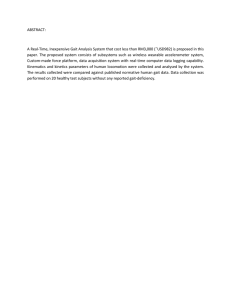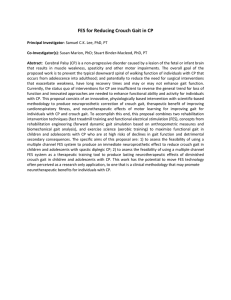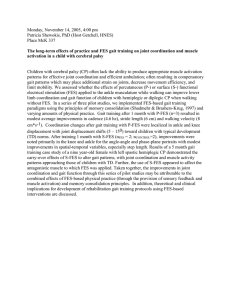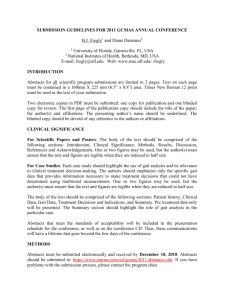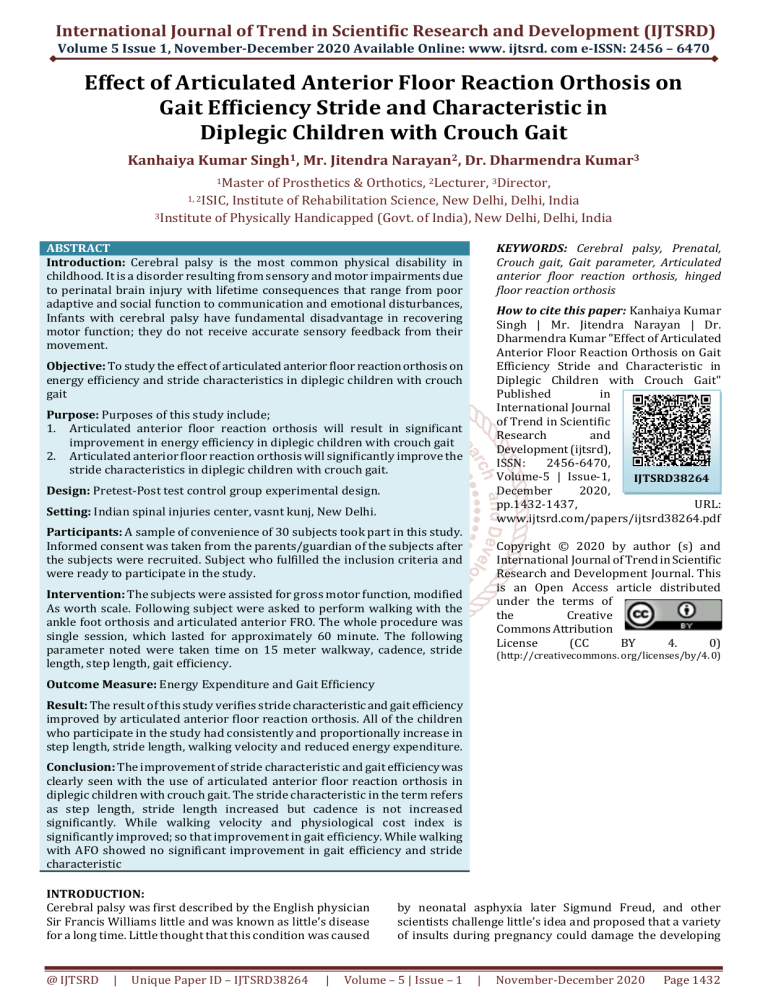
International Journal of Trend in Scientific Research and Development (IJTSRD)
Volume 5 Issue 1, November-December 2020 Available Online: www. ijtsrd. com e-ISSN: 2456 – 6470
Effect of Articulated Anterior Floor Reaction Orthosis on
Gait Efficiency Stride and Characteristic in
Diplegic Children with Crouch Gait
Kanhaiya Kumar Singh1, Mr. Jitendra Narayan2, Dr. Dharmendra Kumar3
1Master
of Prosthetics & Orthotics, 2Lecturer, 3Director,
Institute of Rehabilitation Science, New Delhi, Delhi, India
3Institute of Physically Handicapped (Govt. of India), New Delhi, Delhi, India
1, 2ISIC,
ABSTRACT
Introduction: Cerebral palsy is the most common physical disability in
childhood. It is a disorder resulting from sensory and motor impairments due
to perinatal brain injury with lifetime consequences that range from poor
adaptive and social function to communication and emotional disturbances,
Infants with cerebral palsy have fundamental disadvantage in recovering
motor function; they do not receive accurate sensory feedback from their
movement.
KEYWORDS: Cerebral palsy, Prenatal,
Crouch gait, Gait parameter, Articulated
anterior floor reaction orthosis, hinged
floor reaction orthosis
How to cite this paper: Kanhaiya Kumar
Singh | Mr. Jitendra Narayan | Dr.
Dharmendra Kumar "Effect of Articulated
Anterior Floor Reaction Orthosis on Gait
Efficiency Stride and Characteristic in
Diplegic Children with Crouch Gait"
Published
in
International Journal
of Trend in Scientific
Research
and
Development (ijtsrd),
ISSN:
2456-6470,
Volume-5 | Issue-1,
IJTSRD38264
December
2020,
pp.1432-1437,
URL:
www.ijtsrd.com/papers/ijtsrd38264.pdf
Objective: To study the effect of articulated anterior floor reaction orthosis on
energy efficiency and stride characteristics in diplegic children with crouch
gait
Purpose: Purposes of this study include;
1. Articulated anterior floor reaction orthosis will result in significant
improvement in energy efficiency in diplegic children with crouch gait
2. Articulated anterior floor reaction orthosis will significantly improve the
stride characteristics in diplegic children with crouch gait.
Design: Pretest-Post test control group experimental design.
Setting: Indian spinal injuries center, vasnt kunj, New Delhi.
Participants: A sample of convenience of 30 subjects took part in this study.
Informed consent was taken from the parents/guardian of the subjects after
the subjects were recruited. Subject who fulfilled the inclusion criteria and
were ready to participate in the study.
Copyright © 2020 by author (s) and
International Journal of Trend in Scientific
Research and Development Journal. This
is an Open Access article distributed
under the terms of
the
Creative
Commons Attribution
License
(CC
BY
4.
0)
Intervention: The subjects were assisted for gross motor function, modified
As worth scale. Following subject were asked to perform walking with the
ankle foot orthosis and articulated anterior FRO. The whole procedure was
single session, which lasted for approximately 60 minute. The following
parameter noted were taken time on 15 meter walkway, cadence, stride
length, step length, gait efficiency.
(http://creativecommons. org/licenses/by/4. 0)
Outcome Measure: Energy Expenditure and Gait Efficiency
Result: The result of this study verifies stride characteristic and gait efficiency
improved by articulated anterior floor reaction orthosis. All of the children
who participate in the study had consistently and proportionally increase in
step length, stride length, walking velocity and reduced energy expenditure.
Conclusion: The improvement of stride characteristic and gait efficiency was
clearly seen with the use of articulated anterior floor reaction orthosis in
diplegic children with crouch gait. The stride characteristic in the term refers
as step length, stride length increased but cadence is not increased
significantly. While walking velocity and physiological cost index is
significantly improved; so that improvement in gait efficiency. While walking
with AFO showed no significant improvement in gait efficiency and stride
characteristic
INTRODUCTION:
Cerebral palsy was first described by the English physician
Sir Francis Williams little and was known as little’s disease
for a long time. Little thought that this condition was caused
@ IJTSRD
|
Unique Paper ID – IJTSRD38264
|
by neonatal asphyxia later Sigmund Freud, and other
scientists challenge little’s idea and proposed that a variety
of insults during pregnancy could damage the developing
Volume – 5 | Issue – 1
|
November-December 2020
Page 1432
International Journal of Trend in Scientific Research and Development (IJTSRD) @ www. ijtsrd. com eISSN: 2456-6470
brain. Today it is accepted that only approximately 10% of
case of CP can attribute to neonatal asphyxia. Majority occur
during the prenatal period, and in most of the cases cannot
be identified, the world wide incidence being 2to 2. 5 pre
1000 live birth as much as 70%- 80% of the cases are due to
prenatal injuries, with less than 10% cases being due to
significant birth of trauma or asphyxia 1
CP is seen in 10 –18 % of babies in 500-900grams birth
weight. Prenatal maternal chorimnionitis is also a significant
risk factor accounting for as much as 12 % of cerebral palsy
in the term infants and 28% in premature infants. The
impairment of voluntary motor control is the hallmark of
cerebral palsy. Cerebral Palsy is caused by wide spectrum of
development and acquired abnormalities of immature brain.
It is the most common physical disability in the childhood. In
general term it is described as a group of non-progressive
neurological symptoms which cause impaired control of
movement and which are evident in the first few years of life
usually before age 3. The disorders are induced by damage
or faulty development of the motor areas in the brain,
disrupting the patient's ability to control movement and
posture. Alternation of the central nervous system, which
produce the characteristic feature of CP Children such as
reduced selective muscles, dependence on pattern
movement, abnormal muscles tone, imbalance between
muscles agonist and antagonist, across the joint and /or
deficient equilibrium reaction, result in gait deviation 2.
Most study show that diplegia is commonest form (30 -40
%) of cerebral palsy. with diplegia the lower extremities are
severely involved and the arms are mildly involved,
intelligence usually is normal and epilepsy less common.
Diplegia is becoming more common as more low –birthweight babies survive. In these cases there is flexion of the
hip, knee and to lesser extent elbows that called crouch gait.
1
Crouch gait is one of the most prevalent and troublesome
movement among the children with diplegic cerebral palsy.
Crouch gait is due to abnormally taught and spastic
contracture of hamstring are thought to excessive knee
flexion in many cases. The crouch gait is commonly treated
by surgical length of the hamstring. 3
Orthotic intervention in ambulatory children with spastic CP
is intended to prevent deformity, achieve stable base, and
improve dynamic efficiency of gait and achievement of
motor skill (condie 1995). Although ankle foot orthosis are
frequently used for ambulation of children with spastic CP.
These AFO are primarily prescribed for children with spastic
hemiplegia to prevent equines deformity. 3 Orthosis can
maintain optimum biomechanical alignment of body
segment. Lower limb orthosis may improve gait efficiency by
restoring the prerequisites through the manipulation of
forces acting on the body and reduce energy expenditure
further by decreasing the need for compensatory gait
deviation to achieve locomotion. The extra energy required
using an assistive device and walking device is well known
but quantitative studies of extra energy requirement have
rarely been done. In spastic diplegia, more energy is
required in the initial contact and first rocker cannot take
place, because of the excessive vertical excursion of the
body’s center of mass and additional muscular effort needed
to stabilize the hip, knee, energy is wasted instead. Second
@ IJTSRD
|
Unique Paper ID – IJTSRD38264
|
period of energy wasting may occur during mid stance when
GRF passes through the fore foot creating a flexion moment
and hence planter flexion- knee extension couple. 4
The rear entry hinged floor reaction orthosis (articulated
anterior floor reaction orthosis) major advantage are that it
control second rocker but not interfere with first rocker or
third rocker where as the two earlier design essential
eliminate the ankle movement in the stance phase. it is more
effective than the earlier design and much comfortable.
previous study show that the maximum knee extension of
knee and ankle dorsi- flexion observed during stance phase
in diplegic children. 5
This study focuses on the effects of using an articulated floor
reaction orthosis on the energy efficiency as well as the
stride characteristics in diplegic children with crouch gait.
AIM AND OBJECTIVES
To study the effect of articulated anterior floor reaction
orthosis on energy efficiency and stride characteristics in
diplegic children with crouch gait
HYPOTHESES
1. Articulated anterior floor reaction orthosis will result in
significant improvement in energy efficiency in diplegic
children with crouch gait
2. Articulated anterior floor reaction orthosis will
significantly improve the stride characteristics in
diplegic children with crouch gait.
METHODLOGY
This chapter deals with the methods used in this study.
These include information on the subjects, and procedures
used in data collection, reduction and analysis.
Sample
A sample of convenience of 30 subject took part in this study.
these subject were collected from Akshay Prathisthan school,
Vasant kunj, Orhtotech appliances, 44/5/2/ East Guru Angad
Nagar, Laxmi Nagar, New delhi-92, Indian spinal injuries
center, vasnt kunj, New Delhi. Informed consent was taken
from the parents/guardian of the subjects after the subjects
were recruited. Subject who fulfilled the inclusion criteria
and were ready to participate in the study.
Inclusion criteria
1. The ability to come to standing position independently
without the use of lower extremity orthosis or assistive
device.
2. The ability to walk independently with or without using
ankle foot orthosis.
3. Age ranging between 7 – 12 years.
4. Able to understand the commands given.
5. CP children on the level III as defined by Gross motor
functional classification system.
6. Spasticity measure on modified Ashworth scale 1and 1+
7. Lengthening of hamstring or TA.
Exclusion criteria
1. Athetoid CP
2. Joint contracture of fixed deformity of hip, knee, ankle.
3. Deep sensory disturbance.
4. Visual loss.
Volume – 5 | Issue – 1
|
November-December 2020
Page 1433
International Journal of Trend in Scientific Research and Development (IJTSRD) @ www. ijtsrd. com eISSN: 2456-6470
Instrumentation for data collection
1. Paper walk way
2. A Stoop watch
3. Standard measuring tape
4. Marker
5. Oil & shock
Design
Pretest-Post test control group experimental design
PROTOCOL
A sample of convenience of 30 subject of the age group of 7 12 years was took part in this study. A detailed explanation
of the study given to the subject after that they signed an
informed consent form. Following this, the subject was
divided into two groups of 15 each. Group 1 consists of
control group and group 2 consists of experimental group.
Demography data were collected from the subject who
inclusion criteria of the study. This includes age, sex, height,
and weight. The subjects were assisted for gross motor
function, modified Asworth scale. Following subject were
asked to perform walking with the ankle foot orthosis and
articulated anterior FRO. The whole procedure was single
session, which lasted for approximately 60 minute. The
following parameter noted were taken time on 15 meter
walkway, cadence, stride length, step length, gait efficiency.
Extended Knee with AAFRO
Crouch gait posture-ii
Persisting crouch wearing AFO
@ IJTSRD
|
Unique Paper ID – IJTSRD38264
|
Volume – 5 | Issue – 1
|
November-December 2020
Page 1434
International Journal of Trend in Scientific Research and Development (IJTSRD) @ www. ijtsrd. com eISSN: 2456-6470
PROCEDURE
A signed consent was obtained from the parents/ guardians
of every subject. The diagnosis, age, gender and present
medical condition were obtained from parents / guardian. A
detailed clinical assessment of subject was done. Group 1
consists of ankle foot orthosis user who used AFO more than
one year, while group 2 who used Articulated anterior floor
reaction ankle foot orthosis. The base line data such as heart
rate in the resting condition, heart rate in walking, stride and
step length, cadence, walking velocity were collected from
subjects from group 1 and group 2 separately. To calculate
resting heart rate, the subject rested on a seat and heart rate
was monitored for 10 minute to establish the resting rate.
Then subject stood up and waited until the heat rate
stabilized. On the instruction, the subject walked
continuously along the given walk way path at 15 meter. The
hart rate at end of each walk was measured and also time
taken for each walk was measured. Each subject was given
one trial walking before the final assessment to formalize
with walking condition. Each subject completed one trial for
all of testing condition and asked not to stop and step out
side of paper. The walking trial was realized on paper walk
way (15 x. 05 meter) in a well light environed, at a selfselected speed.
Oil print method was used in the study in which the subjects
were asked to wear socks following which oil is applied to
the sole and impression of foot print were taken. These foot
print used for comparing the stride characteristic such as
stride, step length and cadence. These procedure followed
for collection of post intervention data after 21 days of
intermittent orthotic wear.
DATA ANALYSIS
Statistical analyses were performed using the SPSS software.
A student’s t-test was used to analyze difference between the
groups. Paired t-test was used to analyze the within group
effects. Data were managed on Excel spreadsheet.
RESULT
This chapter deals with results of data analysis for effect of articulated anterior floor reaction orthosis on gait efficiency and
stride characteristic in dialogic children with crouch gait.
Comparison of energy efficiency and stride characteristic with AFO and AAFRO. Paired T – test was used to compare the gait
efficiency & stride characteristic with AFO and AAFRO.
Table 1 Demographic Data – Comparison between Group 1 and Group 2
Group 1 (AFO) (n = 15) Group 2 (AAFRO) (n = 15)
Variable
Mean + SD
Mean + SD
Age
9.7333 + 1.792
9.8667 + 1.807
Height
1.3653 +.088
1.3636 +.083
Weight
32.8000 + 3.986
29.8667 + 3.378
Table 2 Comparison between pre and post data for Group-1
Pre-data N=15 Post-data, N=15
Variable
t-value
Mean
SD
Mean
SD
Step length
.3027
.033
.3020
.032
.23
Stride length
.5020
.035
.5013
.035
.29
Cadence
15.733 1.580 15.333
1.291
1.87
Walking velocity
11.9009 1.013 12.1006
.890
.78
Physiological cost index 1.6307
.357
1.4910
.363
1.27
Table 3: Comparison between pre and post data for Group 2
Pre-data N=15 Post-data, N=15
Variable
t-value
Mean
SD
Mean
SD
Step length
.3067
.027
.3347
.015 3.73**
Stride length
.5013
.044
.5400
.029 3.93**
Cadence
15.5333 1.727 15.3333
.816
.41 NS
Walking velocity
12.1961 1.203 13.3313
.932 4.66**
Physiological cost index 1.4969
.381
1.0927
.315 8.71**
* Significant p<. 001
Table 4 Comparison between Pre and post in Group 1 and Group 2
Pre-data N=15 Post-data, N=15
Variable
t-value
Mean
SD
Mean
SD
Step length
.3027
.033
.3067
.027
.36NS
Stride length
.5020
.035
.5013
.044
.05 NS
Cadence
15.7333 1.580 15.5333 1.727
.33 NS
Walking velocity
11.9009 1.013 12.1961 1.203
.73 NS
Physiological cost index 1.6307
.357
1.4969
.381
.99 NS
NS- Non Significant
@ IJTSRD
|
Unique Paper ID – IJTSRD38264
|
Volume – 5 | Issue – 1
|
November-December 2020
Page 1435
International Journal of Trend in Scientific Research and Development (IJTSRD) @ www. ijtsrd. com eISSN: 2456-6470
DISCUSSION
In the present study an attempt was made to understand
how articulated anterior floor reaction orthosis affect on
stride characteristics and gait efficiency in diplegic children
with crouch gait. No clinical study has investigated the
effectiveness of FRAFO in the CP children with crouch gait.
Most studies discussed in the paper are based on solid or
hinged ankle foot orthosis. The result of this study verifies
stride characteristic and gait efficiency improved by
articulated anterior floor reaction orthosis. All of the
children who participate in the study had consistently and
proportionally increase in step length, stride length, walking
velocity and reduced energy expenditure.
As mentioned earlier, one of the studies supported the
significant improvement in kinematics gait characteristics in
diplegic CP children who wore hinged FRO including a
reduction of knee flexion and abnormal ankle dorsiflexion.
Few published studies have showed that the stride length
increase with floor reaction ankle foot orthosis but the speed
and energy cost not showed any significant improvement.
The ankle foot orthosis trial showed no significant
improvement in stride variable (step length, stride length,
cadence and walking velocity) and physiological cost index.
The articulated anterior floor reaction orthosis concept is to
minimize orthotic involvement at the first rocker (Heel
rocker) and third rocker (Dorsi-flexion) while assisting a
knee extension of toes moment at second rocker. This
orthosis stabilize the ankle and subtalar joint, allowed first
rocker planter flexion and prevent second rocker
dorsiflexion so that the tibia cannot progress anteriorly over
the top of talus, so that the result to prevent knee flexion in
stance.
Clinical Relevance
Crouch gait usually occurs during adolescent growth in
diplegic children. In addition the precipitating factors almost
always include lever arm dysfunction / or previous
weakening of the soleus. Soleus weakening is usually
shortening and comes about either by means of
TendoAchellis lengthening. Because soleus weakness and
LAD both act to diminish internal movement that restrains
forward motion of the tibia, the ankle dorsiflexion during
second rocker. This allow to GRF to move behind the knee
joint so that instead of exerting an extension force, it now
exert a flexion in flexion force on knee in other words, the
PF/KE couple no longer exists.
The anterior articulated floor reaction orthosis used to
restore the PF/KE couple and to keep to the child to in erect
posture. If the patient is maintaining the erect posture, the
soleus and hamstring will stretch and so will not grow
significantly shorter, correct the LAD. So that the patients
walk more frequently knee extension with less energy
expenditure. It implies the use of AFRO in clinical practice
routinely.
Future Research
No Biomechanical studies have checked with the
effectiveness of AAFRO during gait in-patient with CP.
CONCLUSION
The improvement of stride characteristic and gait efficiency
was clearly seen with the use of articulated anterior floor
@ IJTSRD
|
Unique Paper ID – IJTSRD38264
|
reaction orthosis in diplegic children with crouch gait. The
stride characteristic in the term refers as step length, stride
length increased but cadence is not increased significantly.
While walking velocity and physiological cost index is
significantly improved; so that improvement in gait
efficiency. While walking with AFO showed no significant
improvement in gait efficiency and stride characteristic.
REFERNCES
[1] N ardine berker, slime yalcine, (2005), the help to
guide CP, pediaratic orthopaedic & rehabilition
serires pp-1-31
[2]
Chitra sankar & Nandini mundkur(2005)symposium
on developmental & behavioral disorders-I, Indian
Journal Of Pediatrics, Vol. -72
[3]
Dine L dimino, luke E Kelly, Christopher L vaughn
(1995) : effect of quadriceps femoris muscles
strengthing on coruch gait in children with spastic
diplegia, physical therapy, vol-75, no -8
[4]
Allison s. Arnold, Michale H. Schwartz, scott L delp
and velocities of the hamstring in the evaluation and
treatment of crouch gait, gait and posture, 23, 273 -81
[5]
Catheelin E buckon, MS, research associate, Michale
moore CPO, manger, prosthetic and orthotics
department,
comparison
of
three
AFO
(2001)confrigation for children with spastic
hemiplegia, developmental medicine and child
neurology, 43 ; 371-378
[6]
Anderw A. brouno, MD, bakle, Md efficiency of
ambulation determined by oxygen compasuption
meaasurment
[7]
jean stout and steveen coop, energy expenditure in
CP, the treatment of gait problem in CP, pp -146164
Gage
[8]
Jamesh R gage and Deborah S. quanbenk, otrhortic
and mobility aids in CP PP-273- 285
[9]
Orthopedic assessment of CP, spastic diplegia, pp282-302
[10]
Orthotic management of CP, journal of prosthetic and
orthotic, 2002 pp- 154 – 162
[11]
Jamesh R. gage michle Schwarz, pathological gait and
lever dysfunction pp. 180 -204 Gage
[12]
Neill stuart Thompson, M. D, F. R. C. S (Trand orth),
Richard jonathan baker, ph. D & Trevor childs taylor,
F. R. C. S (2001)Relevance of the popliteal angle to
hamstring length in cerebral palsy crouch gait,
Journal of pediatric ortopaedics, 21:383-387
[13]
Jhon R. fiskj, terry j. supan, cerebral palsy, pp. 533541 Atals of orthotic ii edition
[14]
Perry J, Gait analysis methodology in normal and CP
pp. 120 -125, Perry J
[15]
Euger E bleck, MD, standfrd university school of
medicine standard california, special assessment and
investigator, 1999/2000, clinics in development
medicine orthopaedic management pp 65 – 205
[16]
Raja, Kavita MSPT, Joseph, Benjamin Mch ortho, Rana
vinay MD (2007), Physiological Cast index in cerebral
palsy: it role in evaluating the efficiency of
Volume – 5 | Issue – 1
|
November-December 2020
Page 1436
International Journal of Trend in Scientific Research and Development (IJTSRD) @ www. ijtsrd. com eISSN: 2456-6470
ambulation, Journal of pediatric orthopaedic, vol. (2),
p-130-136
[17]
Paulo Robert Garcia lucareil, Mario de oliver lima,
change in joint kinematics in children with cerebral
palsy while walking with or without floor reaction
ankle foot orthosis, clinics, 2007, 621(1): 63-8
[18]
Methods of gait analysis, gait analysis : an
introduction, pp- 154
[19]
C. N duffy, M D, F. R. C. S (TR& orhto), H. K. GRAHAM,
M. D, F. R. C. S, A. P. cosgrove, m. d, f. r. . c. (ortho),
(2ooo), the influence ankle foot orthsis on gait and
energy expenditure in spina bifida, journal. pediatric
orthp, 20, 3
[20]
Diane L. damino, Edward laws, mark F. able (2006),
relationship of spasticity to knee angular velocity and
@ IJTSRD
|
Unique Paper ID – IJTSRD38264
|
motion during gait in cerebral palsy, gait & posture,
23, -1-8.
[21]
F. Danion, E. varieaine, M. bonard, J. pailhoius (2003),
stride variability in human gait : the effect of stride
frequency and stride length, gait & posture, 66-77.
[22]
B. W. stansfield, S. J hilman, M. . E hazelwood, A. M
lawsan, A. M. mann (2003), normalization of gait data
in children, gait & posture, 17, 81-87
[23]
Allison s. Arnold, M arcs G pandy, Scott L. delp (2005),
muscular contribution of hip and knee extension
during the single limb stance phase of normal gait : a
frame work for investigating the cause of crouch gait,
journal of biomechanics, 38, 2181-2189
Volume – 5 | Issue – 1
|
November-December 2020
Page 1437

